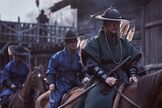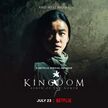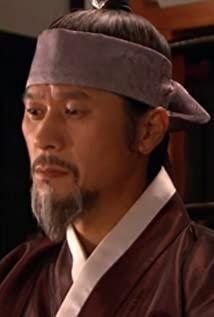The main creators of this film have referenced too many historical events and historical figures, and designed a very complicated historical background for the plot, which involves many events in real history.
Therefore, it is necessary for me to break down the historical background of this play and explain them one by one.
1. The "Little Heavenly Plot" of Dynasty Costume Dramas in Korean Film and Television Industry
Comparing the historical-themed film and television dramas and historical documentaries of China and South Korea in the past one or two decades, one characteristic can be found: the two sides’ attention to the Qing Dynasty and the depiction of Jurchens/Manchurians are completely different. .
Many years ago, a joke was circulating on Internet community forums:
The Qing army entered the customs in 1644 and made outstanding contributions to the Chinese film and television industry in the 21st century.
The Qing palace dramas in Chinese film and television dramas have long been dominated by joking entertainment dramas. This kind of subject matter basically has no ancient rhyme. Secondly, these Qing palace operas will not highlight the national characteristics and historical accumulation. They hit "Yongqing Shengping (Private Interview by Kangxi Weifu)" and "Monarch and Minister Fighting" that appeared in the early years of the Republic of China. The themes of martial arts and palace fighting, even though there are Qing dynasty costumes, Qing dynasty hairstyles and Manchu emperors everywhere, the plots are all stories that cater to the tastes of entertainment nowadays.
However, South Korea's recent "(Lee's) Dynasty costume dramas" involved the content of the Qing Dynasty. Most of them focused on the historical period of the rise of Jianzhou Jurchen, the two eastern expeditions of the Qing Dynasty, and the establishment of suzerainty-vassal relations between the Qing Dynasty and North Korea. In today's South Korea, in addition to some historical research institutions, those very influential media organizations and cultural organizations have also spread the concepts of the "War between the Koreans and the Qing Dynasty and the Korean-Kingdom War" to the public for a long time.
The entertainment industry and the film and television industry are the carriers of popular culture and popular culture in a country, reflecting the value judgments of civil society on history.
Affected by the Qing palace operas, especially the various "gong fighting" operas in the past ten years, Qing history is the most interesting piece of history for the general public in China. In the autumn of 2017, I accompanied my friends to the Forbidden City and found that the tour guides with tour groups had the same commentary and were closely integrated with the popular TV series, maintaining the style of a Zhen Huan popping out every two sentences on average.
The Chinese mass society’s impression of the Qing Dynasty is that it was the last monarchy and feudal centralized power in traditional Chinese society, and it was part of the ancient history of China. Not many people know about the pre-Qing history of the 15th and 16th centuries involving the Jurchen tribe outside the Liaodong border wall.
Today, the Korean public's understanding of the Qing Dynasty is the last celestial kingdom under the traditional tributary system of East Asia.
Today, all walks of life in South Korea have divided this history into two stages: "controlling the Hu" and "big things", and viewed it from the perspective of two divisions: the former focused on the establishment of vassal neighbourhoods in the Joseon Dynasty and the Jurchen tribe. The "little heaven" of the relationship, the latter focused on the suzerain-vassal relationship between Lee Korea and the Qing Dynasty.
The rise of Jianzhou Jurchen and the Ming and Qing wars are in a transitional period of two stages, and it is a springboard for ending the first stage and opening the second stage. The unpredictable situation and the unpredictable impact will inevitably leave a deep historical imprint on future generations, and there will inevitably emerge bright characters for processing and refining and wonderful stories for excavation and interpretation.
Therefore, today’s Korean society’s impression of the Qing Dynasty and the Manchus is not Qianlong, the romantic emperor who likes to go down the Jiangnan and greedy for fun, or Kangxi who visits privately in the storytelling quyi section, or Yongzheng who "I am such a man and has such a temperament." It is the Huangtaiji of Sandadu, Buzhantai who invaded the six towns with long swords and heavy armor, and Wudiha on the opposite bank of the Tumen River and the Yalu River, deep in the dense forests of the Baishan and Heishui mountains.
Wudiha, the transliteration of the Jurchen language weji, means the forest nation. Lee Chosun used this term to call the Jurchen tribe, with a certain derogatory meaning, meaning "savage in the forest."
2. Abandoning four counties, Manpu Port, and Weiyuan crisis
1. Waste four counties
From the late reign of King Sejo King Lee Gao (approximately Ming Xuanzong in the early Ming dynasty to Ming Yeongjong period), North Korea also experienced similar incidents of abandoning soil and shrinking borders in the Ming Dynasty, that is, "removing the four northwestern counties."
When King Sejong was reigning, North Korea expelled the Jurchen tribe and opened up the four counties of Cicheng, Maochang, Yurui and Luyan on the south bank of the upper Yalu River, built fortresses and cities along the river, and stationed border troops. Due to the remote location, the obstacle of high mountains, the difficulty of food supply and personnel transfer, the four counties barely managed to operate for more than 20 years. During the reign of King Sejo, they gave up one after another, and the frontier troops withdrew to the south. After that, along the Yalu River, North Korea defended a few ferry crossings.
At the beginning of the film and at 29-30 minutes, maps appeared respectively, which marked the names of places or tribes such as Abandoned Sijun, Manpu, and Pozhuwei.
Here I have to correct it: the abandoned four counties appearing in the two maps of the movie are all marked in the east of Manpu Town and the east bank of the middle reaches of the Yalu River. This is wrong. The position of the "Fanhu Tribe" is also wrong.
The four disused counties are located at the northern foot of the Langlin Mountains in the northern part of the Korean Peninsula, on the northwest side of the Gaema Plateau, and on the south bank of the upper reaches of the Yalu River. It is located in the north of Jijiang Road and the west of Liangjiang Road in North Korea today, and the northwest of North Korea. Their prefectures are all close to the south bank of the upper reaches of the Yalu River, so there are also nicknames such as "four counties in the south of the Yangtze River, four cities (counties) along the river, and four counties in the northwest".
The name of Cicheng County has not changed, and it is still called Cicheng today;
Yu Rui is in Tucheng in Zhongjiang County of Cijiang Road today;
Lu Yan is Zhongjiang in Zhongjiang County of Cijiang Road today;
Maochang is Houchang in Jinhengji County, Liangjiang Road today.
The diagram is as follows-
The four red circles are the abolition of the four counties. Today's Tucheng is a very small place, and no place names are marked on this map.
I also used white circles to mark Manpu, Weiyuan, and Hunjiang in Liaoning, China. These locations are also extremely important and will appear many times later.
2. Manpu.
Manpu is under the jurisdiction of the Jiangjie Duhu of Ping An Province. It is the place where North Korea implemented military deterrence against Jianzhou Jurchen, border trade activities, and private diplomatic exchanges. Therefore, Manpu is not only a military town, but also a port and border city trading point.
As for "private diplomatic exchanges", it was because the Ming Dynasty believed that Jianzhou Sanwei was a jail guard who called him vassals. It was the sphere of influence of the Ming Dynasty and did not belong to the small vassal system of North Korea. Therefore, the Ming Dynasty always opposed the exchanges between North Korea and Jianzhou Jurchen, and emphasized the "selfless relations between people and ministers." However, the upper reaches of the Yalu River were remote and very hidden, and far away from the Ming Dynasty Liaodong. Even if the two sides went privately, it would be difficult for the Ming Dynasty to interfere.
During the Chenghua period, the Ming dynasty joined the Korean army to conquer Li Manchu, and the Korean army was assembled from Manpu. In the last years of Wanli to the Tianqi and Chongzhen years, the frequent exchanges between Nurhachi and King Xuanzu and Gwanghae of Korea also passed through Manchu. Pu realized.
After North Korea abolished the four counties, Manpu became the most remote military town and port along the Yalu River, which was equivalent to Kaiyuan or Fushun in Liaodong during the Ming Dynasty.
The plot and character dialogue of the film also mentioned Manpu many times.
3. Weiyuan.
In the summer and autumn of the 23rd year of Wanli, Jianzhou Jurchen crossed the Yalu River many times and entered Weiyuan County to collect ginseng. There were continuous conflicts with North Korea’s guards along the river. In early August of that year, the Weiyuan County Shoujin Dahu led his troops to set up an ambush and ambush a group of Jurchens who crossed the border to plan ginseng, causing 27 deaths and injuries in the latter.
Afterwards, Nurhachi sent his confidant Ma Chen, as the representative of Jianzhou Nuzhen to negotiate, crossed the Yalu River to Manpu, and asked the Manpu envoy to punish Jin Dahu and other requirements, and ordered North Korea to reply within a time limit. He threatened to get a satisfactory answer. , So he threw troops to avenge the invasion of Jiangdong.
This is the Weiyuan crisis.
Although the film does not mention Weiyuan, the background of the film mainly refers to the historical event of the crisis in Weiyuan. In the film, the Lord Jiedushi is based on the Weiyuan County Shoujin Dahu who killed the Jurchen ginseng pickers by setting up an ambush .
4. Hunjiang.
The Hunjiang River is the largest tributary of the Yalu River Basin, which is also the Pozhu River and Tongjia River in the Ming Dynasty. The prototype of "Pozhuwei" in this film is Nurhachi's newly-built Zhouzuowei.
Before the "Battle of Chenghua Dinghai" by Ming Xianzong, Jianzhou Nuzhen existed in the structure of Jianzhou Sanwei. The space of influence of the three guards is as follows:
Jianzhouwei, where Li Man lives, is mainly active in the Tongjiajiang River Basin (Pozhu River).
Dongshan’s Jianzhou Zuowei was active in the Suzi River Valley and Daya River Valley located south of Wuling;
Fancha and his descendants, Jianzhou Youwei, were active in the upper and middle valleys of the Hun River, which is located to the north of Wuling and outside the mouth of the Suzi River.
But a century after the "Battle of Chenghua Dinghai" ended, the pattern of Jianzhou Sanwei was gradually broken. After the eleventh year of Wanli in the late Ming Dynasty, only Nurhaci was the leader of Jianzhou Zuowei.
When the Weiyuan Crisis occurred in the 23rd year of Wanli, there was no Jianzhou Guard or Jianzhou Right Guard, only the New Zhou Zuowei. Nurhaci is the leader of the newly built state left guard. At this time, he had unified the various ministries of Jianzhou Jurchen, and had just received the post of "General Longhu" from the Ming Dynasty. He and the Ming Dynasty are in a political honeymoon period of mutual appreciation and use of each other, and their relationship is very harmonious.
Nurhachi had ruled over tens of thousands of people at that time, and was a strong Jurchen tribe near Liaodong. It was unlikely that he would go out in person. The leader of Po Zhuwei in the film is also mainly fictional.
2. Xiaotian Dynasty, Six Towns Fanhu, Water Tribe
1. Xiaotian Dynasty
Korea and North Korea have historically claimed vassals to China's Song, Liao, Jin, Yuan, Ming and Qing dynasties, and are important vassal states in the vassal and vassal diplomatic structure of the "Family World" of the Chinese Empire.
However, Goryeo and North Korea, also in the Tumen River and Yalu River valleys, have long operated their own small heavenly dynasties and small vassals against the Jurchen tribe.
The heroine's father is the leader of the small Jurchen tribe who is loyal to North Korea.
In real history, there are many similar events and people. For example, in the 9th year of Emperor Xiaozong's Hongzhi (1496), North Korea appointed Tong Qingli as an envoy and went to Jianzhouwei to negotiate and investigate.
Tong Qingli is a descendant of North Korea's "Xianghua Jurchen". His grandfather is Yuxuli, the younger brother of Meng brother Timur. In the Yongle reign of the early Ming Dynasty, Meng Ge Timur accepted Ming Chengzu's invitation and abandoned the dynasty to join the Ming Dynasty. The tribe of Yuxuli did not accept Ming Chengzu’s reassurance, insisted on loyalty to North Korea, and accepted the official position granted by King Taizong of North Korea. Their descendants intermarried with the two groups of nobles and became the naturalized Jurchens of North Korea.
2. Six Towns Fan Hu
There should be no need to explain in detail about the Six Towns Fan Hu, just a few words:
At the end of the Yuan Dynasty, the Jurchen tribes such as Vodori and Huligai descended south from the Mudanjiang River basin and entered the lower reaches of the Tumen River for activities on both sides of the river. Then they contacted Goryeo/North Korea. The two sides clashed and reached a small sect led by Lee Korea. Fan relations. However, during the Yongle period, Ming Chengzu insisted on operating the Tumen River Basin. Ahachu and Mengge Timur successively accepted the recruitment of the Ming Dynasty and became the Jurchen Jianzhou Guards. After that, the relationship between Jianzhou Jurchen and North Korea deteriorated sharply. North Korea used force to expel Jianzhou Jurchen.
By the time of Emperor Xuanzong of the Ming Dynasty, the Ming Dynasty implemented a policy of greatly reducing borders and abandoning soil. Ming Xuanzong not only abandoned Nurgandus, but also withdrew from the Tumen River basin. North Korea adopted the method of building fortresses along the south bank of the middle and lower reaches of the Tumen River, slowly advancing, forcing Jianzhou Jurchen to move westward to the Tongjia River and Hun River.
However, after Jianzhou Jurchen moved westward, a large number of small Jurchen tribes remained in the Tumen River Basin. There were scattered tribes of Jianzhou Jurchen, as well as new tribes that successively moved from Mudanjiang and Wusuli Jiangnan.
North Korea built six fortress formations on the south bank of the middle and lower reaches of the Tumen River to form a defense system along the river, which is the "six towns." The Jurchen tribes who stayed in the middle and lower reaches of the Tumen River and made tribute to North Korea accepted the official posts granted by North Korea. They are the six towns and the bottom of the city, and they are also called "Walkha Jurchen."
The four counties in the northwest and the six towns of Tumen River are shown as follows——
In a period of two hundred years, due to many Fan Hus distributed in the Tumen River Basin. In places such as the six towns, they co-located and intermarried with the border residents of Hamgyong-do, North Korea. Therefore, the six-towns of Hamgyong-do formed a special cultural atmosphere.
The local Korean dialect absorbed a large number of Jurchen vocabulary to form the "six-town dialect"; the local frontier army and border residents were also flooded with naturalized Jurchens or Jurchen/Korean mixed descendants born through marriage.
Twenty-three years after Wanli, Nurhaci accelerated the pace of eastward advancement, and absorbed a large number of Varkha Jurchens and North Korean border residents from Hamgyong Road and Ping An Road.
In the film, the father of the heroine Ashin does not have any braids on his head, but a hairdo in a bun. This is his allegiance to North Korea, expressing the meaning of Xianghua.
Even so, due to the superiority of Goryeo/North Korea in the "state of ethics and education" (North Korea especially values "things and Confucianism"), both the upper class nobles and ordinary people generally treat Jurchen, Mongolia, and Khitan. Hu people regarded as barbarians and Wudiha (the savage in the forest), who always discriminated against
3. Water tribe
Above and under water refer to the upstream and downstream of a river.
Water tribes are Jurchen tribes that are active in the upper reaches of a river.
In this film, through the dialogue of Ashin's father, it can be judged that this is a small tribe living on the upper reaches of the Yalu River, near the abandoned four counties.
In the Wanli era, there were huge differences in the way of life/production among the Jurchen tribes.
Jianzhou and Haixi Hada, and other nearby Jurchens in Liaodong, have completely transferred to the serf system farming economy and horse market trade economy; the Savage Jurchens of the Wusuli River are still fishing and hunting.
As for the floating tribes, underwater tribes, and Varkha Jurchens in the Yalu River and Tumen River Basins, they are living in the border city, where fishing and hunting and farming are mixed. The main reason is the instability of the living environment.
The mountainous and rainy Changbai Mountain valley lacks arable land, and the conquests from North Korea and the frequent vendettas among the tribes have forced some small tribes to move continuously.
Where the person is, it is the tribe. The tribe of the heroine Asin, living in the upper reaches of the Yalu River today, is the floating tribe;
Tomorrow will move to Jianzhou to seek refuge in Nurhachi, which is Jianzhou Jurchen
The day after tomorrow, he moved to Tumen Jianghuining, and wanted North Korean officials to pay tribute to beg for officials.
3. Jurchen's eastward movement
1. "Jurchen is full of tens of thousands"
Jurchen is full of thousands, when did it appear?
Some people would say it was in the Nurhaci era.
Wrong, in the early stage of Wanli, with Hexi Hada and Ye He as the heads, they already had the strength of over ten thousand people.
In the last years of Jiajing, the Ming Dynasty adopted the "Dongyi Chang" proxy policy for Liaodong Jurchen, that is, to find a Jurchen chief who has certain strength and is willing to cooperate with the court, and let the band take charge of the tribe. The Ming Dynasty adopted this "Dongyi Chang". The effectiveness of maintaining the stability of the frontier fortress in eastern Liaoning at a very low cost.
The first General Longhu, Hada Wangzhong/Wangtai uncle and nephew are typical.
The "Dongyi Chang" agent policy led to the first wave of tribal mergers in the Liaodong Jurchen in the late Ming Dynasty, and the emergence of Hada and other large tribes.
The second impact of the “East Yichang” policy is to promote the Jurchen tribes near the eastern part of Liaoning to develop to the east. The indigenous Jurchen tribe in the Menjiang River Basin destroyed the Xiaotian Dynasty in North Korea.
Nurhachi first unified the establishment of Jurchen, and defeated the nine coalition forces headed by Ye He in the Battle of Gule Mountain in the 21st year of Wanli. Then he went north from the Tongjia River and conquered Zhusheli, and began to enter the upper reaches of the Yalu River and the map. On the upper reaches of the Yangtze River, also joined the army of eastward advancement.
During this period, the Imjin War broke out. After the end of the first phase of the Imjin War, the Japanese army did not withdraw from the Korean peninsula, but built a fortress at the southern end of the peninsula, maintained the port, and confronted the Ming/Korean coalition forces for a long time.
North Korea must deploy most of its forces in the south, and the north two river defense lines are empty, which provides great convenience for the Jurchen eastward movement.
The more grand historical background of this film is the Imjin War and the Jurchen Eastward Movement of the same period. Jianzhou Jurchen not only infiltrated North Korea, but also developed power in the upper reaches of the Yalu River and the Tumen River Basin.
Jianzhou, Hada, Ula, and Yehe all scrambled to send troops to the Tumen River Basin, sending envoys and Meyen to contact the local indigenous Jurchen tribe.
Meyen means squad and queue in Jurchen language. The powerful big tribe in eastern Liaoning sent Meyen to the Tumenjiang Jurchen tribe with the main purpose of collecting mink tribute and rewarding ulin, using various methods of both soft and hard, so that the local small tribes would be loyal to themselves.
In 27 minutes of this film, Ashin’s father, Dusi, crossed the Yalu River and told the people of Zhusheli in Changbai Mountain (Zhusheli, tribe name) that the tiger killed 15 Pozhu Guards and Jurchens. The interjecting Jurchen and him The two entourages behind him were the members of Meyen sent by Pozhuwei to inquire about the news and monitor the actions of the Asin tribe.
Finally, I think the setting of the film is too tight in general.
The director and screenwriter designed an extremely grand and complex historical background for the film, referring to many famous historical events (compared to the history of North Korea, it is very famous, but many things are not mentioned in Chinese history books, and few people know about it). But the film is only 92 minutes long.
At 92 minutes, it is necessary to advance the storyline and shape the characters. In this case, it is hard to add intricate historical background elements. The result of this is that I wanted to say everything and I wanted to express it, but I didn't say anything thoroughly, so I just passed by, and the structure of the story seemed a little messy.
That's roughly it. Other officials' Jurchen arrows and letters are also shown in this film, so I won't go into more details.
View more about Kingdom: Ashin of the North reviews








